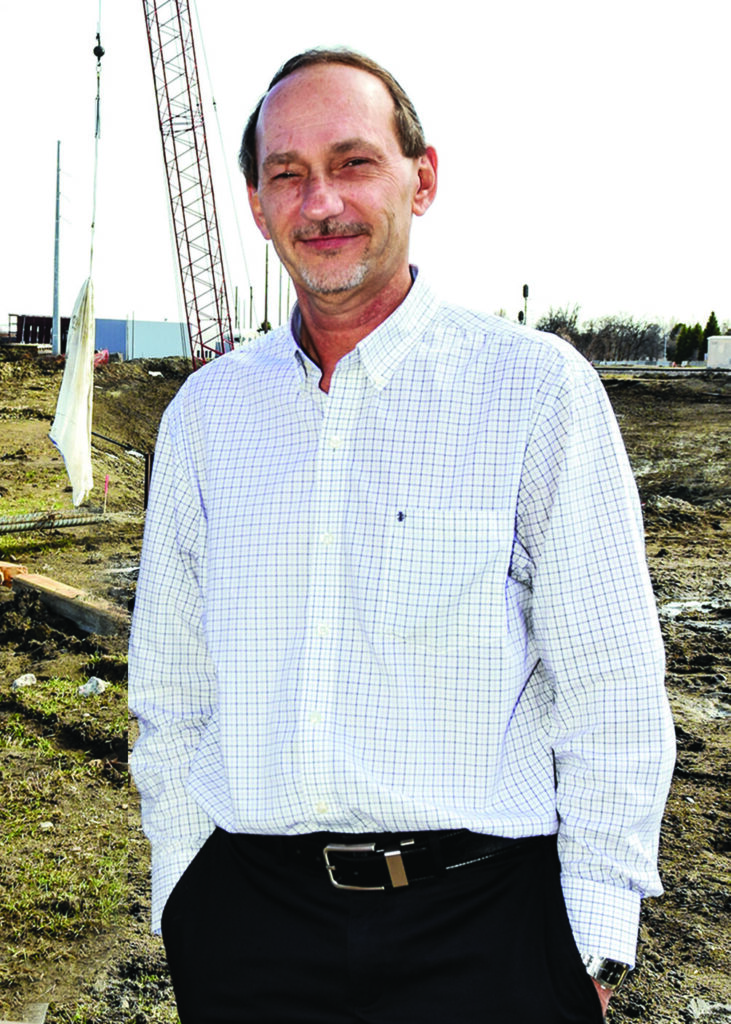
City engineer Bob Zimmerman, who has spent his entire career in Moorhead, is Minnesota’s Municipal Engineer of the Year. Photo/Russ Hanson
Nancy Edmonds Hanson
Bob Zimmerman has shaped the physical side of Moorhead since he was in college. From fighting floods to improving sewers, from quieting the toots of ever-present trains to finding ways to channel motorists around the tracks, he has left an indelible mark on the city’s infrastructure.
And now his contributions have been recognized by his peers. This week the City Engineers Association of Minnesota announced that Zimmerman – “Dr. Bob” or “Dr. Z” to his many friends and colleagues – has been named Minnesota’s Municipal Engineer of the Year.
The Ulen, Minnesota, native has spent his entire career at the city’s service. From an internship in the wastewater division as an undergraduate at North Dakota State University to head of the 35-member engineering department for nearly 20 years, he and his team have solved problems on the side of the city that residents take for granted – until something goes wrong.
“I’ve worked for the city since 1984, when I spent four summers here as I completed my bachelor’s, master’s and doctorate at NDSU,” he says. “Over the years I’ve had opportunities to go elsewhere in the private sector here and in other parts of the country. But ever since I started, I’ve found so many challenges that have been fun to work on that I’ve just never wanted to leave.”
Zimmerman was nominated for the prestigious statewide honor by his colleagues in city government. His nomination was endorsed by local and regional agencies that have worked with him – among them the Minnesota departments of transportation and natural resources, the F-M Flood Diversion Authority, the city of Fargo and both Cass and Clay counties.
A farm boy who excelled at math and science, Zimmerman originally was drawn to structural or civil engineering. His summer job with the wastewater plant, he said, drew him more toward environmental work … so much that his master’s studies had an environmental focus. That led to his first full-time job as superintendent of environmental systems, where he became involved in a long-drawn-out struggle with the Minnesota Pollution Control Agency over how to remove ammonia in treated wastewater dispensed back into the Red River.
“I credit Mayor Morrie Lanning’s leadership in challenging regulation that we considered impractical,” he said. The city carried its objections and counterproposal all the way to the EPA in Washington, D.C. – and won. “After years and years,” he said, “we arrived at a cost-effective solution using new technology. We were one of the first cities in the country.” That solution, dubbed the Moving Bed Biofilm Reactor, “saved the citizens of Moorhead millions of dollars,” he notes. It’s still in operation today; he has published papers and given presentations all over the nation to engineers and scientists.
Zimmerman was named city engineer in 2002, a time when the city had begun to pursue funds for the 34th Street/I-94 interchange, the Southeast Main/20/21st Street underpass and the upcoming 11th Street railroad underpass. Those projects emerged from a controversial study of railroad crossings that wrapped up just before he took over.
Its original focus was moving the troublesome railroad tracks out of town. “That ran into lots of opposition, especially from landowners outside the city limits,” he recalls. Instead, the three enormous road projects became the compromise favored by all parties … setting off decades of lobbying for federal and state funding.
The first portion, 34th Street, was underwritten with federal funds through the earmarks process that Congressional delegations once could use to get favored projects passed as ride-alongs to larger bills. When they were outlawed by Congress ten years ago, the challenge for the rest of the project grew dramatically. The state legislature eventually funded construction of the nearly complete 20/21st Street project and last year appropriated construction funds for the Department of Transportation to undertake work on 11th Street. With preliminary design work underway, its construction is expected to start in 2024.
The city engineer called the quest for permanent flood protection the biggest challenge of his tenure. Largely complete by now, the long-term undertaking was born after the end of the epic flood fight of 2009, when the Red River exceeded all previous records. All three divisions of the engineering department have been involved in the planning, design and construction of the decade-long project, achieved at a cost of $110 million. “We learned from watching how other communities got funding for protection after 1997, and used those lessons ourselves after 2009,” he said. “I hope that was the biggest crisis that I’ll ever see in this position.”
Generally calm and soft-spoken, Zimmerman admits that he appreciates the statewide honor that was bestowed at the engineering group’s virtual convention this week. But he is quick to share.
“I’m grateful for the recognition, but this job is all about the team,” he emphasized. “I work with a wonderful group of talented people. What all of them do has made it fun to lead for all these years.”
Which is not to say that his service has been trouble-free. “Day to day, we’re on the ground,” he pointed out. “We get a lot of calls. Some are easy to solve. Some, not so easy.
“At the end of the day, though, it’s gratifying to think of how the city benefits from the work we have done. That’s the thing about working and living in Moorhead. We do a project … and then we get to live with it, too.”


